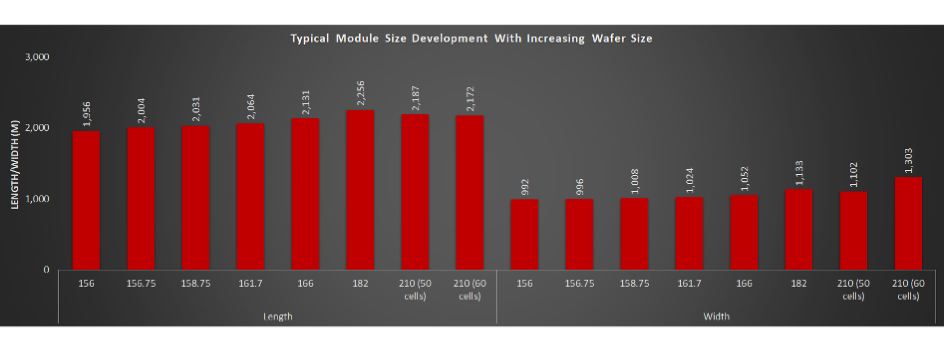- The standard 156mm wafer size has been increasing over past few years resulting in an increase in module size
- Commercialization of 156.75 mm wafer in 2017 was the first step towards increasing the wafer size, by which module length increased by 48 mm and width by 4 mm
- Length increases more prominently with wafers growing larger compared to horizontal expansion, while 210 mm 60-cell configuration is an exception
- Modules based on M6 wafer format have a typical surface area of 2.24 m2, for M10 the surface area is around 2.56 m2 and G12 so far comes in two modules sizes of around 2.41 m2 and 83 m2
Increasing wafer size increases module power, but it also makes modules larger. As the wafer sizes have been increasing over the years, more prominently since 2018, the module size has also started increasing. The 156 mm wafer size, which was a standard for more than a decade, typically results in module area of 1.95 m2 in a 72-cell module configuration. The world’s largest wafer manufacturer LONGi has commercialized the 156.75 mm wafer also called as M2 in 2017. This 0.75 mm increase in wafer size length has increased a typical module length by 48 mm and 4 mm in width, corresponding to the module area of 2 m2.
The next increase in wafer size took place in 2018. JinkoSolar released its Cheetah modules using 158.75 mm full square wafer called G1 and these modules have an area of 2.05 m2. The modules using these wafers have a typical dimension of 2,004 x 996 mm. During the same time, another large wafer format called M4 with size 161.75 mm was used by few module manufacturers such as LG. Such a module has module surface area of 2.11 m2.
Canadian Solar in 2019 introduced a module using 166 mm wafers and based on PERC and MBB technology. The modules based on M6 wafer format have a typical surface area of 2.24 m2. Within 3 months after commercial modules with M6 hit the market, Chinese mono ingot/wafer manufacturer Tianjin Zhonghuan Semiconductor (TZS) launched a 210 mm wafer product that eventually was called G12 due to its full square format.
Only 4 months after the introduction of 210 mm, in December 2019, Risen Energy was the first to launch a 500 W+ module based on these larger wafers. Such modules in a 50-cell configuration have a typical surface area of 2.41 m2. Now, a group of integrated companies are pushing an intermediate size of 182 mm referred as M10. These modules with a length of 2,256 mm and width of 1,133 mm have a surface area of 2.56 m2.
While larger wafers mainly influence the length of module more pronouncedly than width, the 60-cell configuration of 210 mm based module is an exception. These modules have a width of 1,303 mm and length of 2,172 resulting in a surface area of 2.83 m2.
For detailed information on larger wafers and module size, see TaiyangNews report on 500W+ Solar Modules, which can be downloaded for free.












